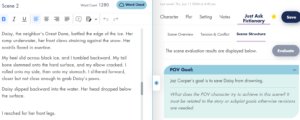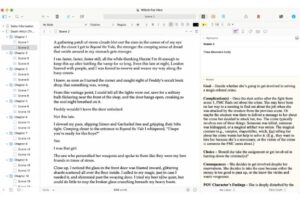
Fellow word-slingers: writing a book can be an exhilarating, soul-consuming, and downright exhausting endeavour.
But fear not!
Like a literary superhero, I’m here to save the day with my trusty sidekick: book writing software. That’s right! Technology has given us the gift of writing tools that can make our literary lives easier, and possibly even enjoyable.
Now, before you roll your eyes so hard they fall clean out of their sockets, hear me out.
I know choosing the right writing software can feel like trying to find a fancy stylus in a haystack of digital clutter. But worry not, I have sifted through the rubble and emerged victorious, wielding a list of the top 5 book writing software programs for your perusal.
In this article, we’ll delve into the nitty-gritty of each program, exploring their features, quirks, and unique superpowers that will help you take your manuscript from a mere twinkle in your eye to a polished, published masterpiece. And because I’m feeling generous, I’ve also included some handy tips on what to look for in book writing software, and answers to frequently asked questions about using these literary lifesavers.
So, strap on your writing cape, grab a cup of your preferred caffeinated beverage, and let’s embark on this whirlwind tour of the best book writing software of 2023
Having these powerful tools at your fingertips will prime you to conquer the literary world one word at a time.
Let the adventure begin!
Take a free trial of Fictionary today and take your story to the next level.
5 Brilliant Pieces of Book Writing Programs
Here are our top five favorite pieces of software for writing a fiction book.
#1 Fictionary: Best Overall Software for Writing a Book
Developmental editing is the Achilles’ heel for many authors, myself included.
It’s the stage where we dig deep, examining our story’s skeletal structure for any weaknesses or cracks. Does the plot make sense? Are the characters compelling and evolving? Is the pacing on point? More often than not, we find ourselves drowning in a sea of questions and doubts, struggling to breathe life into our narratives.
This is where Fictionary comes in, acting as a beacon guiding us through the choppy waters of developmental editing.
Fictionary is not just any software.
It’s a revolutionary tool that shifts the paradigm of editing. It helps us dissect our story into digestible pieces, enabling us to examine each element in isolation and relation to the whole.
It ensures we maintain a steady pace, keep our characters consistent, and our plot engaging.
It’s like having a personal editor at your disposal, providing you with objective and insightful feedback at every stage. And the best part? It’s all automated. No more waiting for weeks to receive feedback from a busy editor. With Fictionary, you get instant analysis and suggestions to improve your manuscript.
But don’t take my word for it.
Try Fictionary for yourself, and experience the transformation it can bring to your writing process. Fictionary is a lifeline for authors like us, struggling to stay afloat in the turbulent sea of developmental editing.
So, dive in, and let Fictionary guide you to the shores of a polished, compelling story.
The Fictionary Story Arc
Plot development is a key aspect of storytelling that many writers grapple with.
Crafting a compelling story arc can feel like navigating a labyrinth without a map, constantly second-guessing yourself at each turn.
Are my plot points placed correctly? Does the conflict escalate at the right pace? Is the climax satisfying and resonant? The list of questions and uncertainties is exhausting and endless.
Enter the Fictionary Story Arc, a feature that brilliantly demystifies the complexity of plot development.
Think of Fictionary’s Story Arc as your personal GPS for navigating the maze of your plot. It breaks down your narrative into distinct, manageable segments, helping you to pinpoint key plot points and ensure they’re unfolding in a timely, coherent manner.
This tool is like having a seasoned editor guiding you to place your key plot points at the optimal positions in your manuscript.

The key plot points are:
- The Inciting Incident
- Plot Point 1
- The Middle Event
- The Climax
- The Resolution
Whether you’re crafting a sprawling epic or a tightly-woven novella, the Story Arc feature ensures that your plot maintains an engaging pace and logical flow.
It eliminates guesswork, replacing it with clear, concise, and actionable feedback, thus giving your story the structure it needs to captivate your readers from the first page to the last.
With Fictionary’s Story Arc at your fingertips, you’re no longer wandering aimlessly in the plot development labyrinth. Instead, you’re confidently crafting a narrative that resonates, engages, and ultimately, satisfies. It’s an essential tool for any writer seeking to elevate their storytelling craft.
Character Arc
One of the toughest hurdles writers face is crafting a compelling character arc.
This journey is more than just a plot device—it’s the emotional and psychological evolution your protagonist undergoes from the beginning to the end of your story.
It’s no easy task, but guess what? Fictionary can help.
Remember, the Fictionary Character Arc focuses on whether the protagonist moves closer to or further away from achieving their story goal. This is central to creating dynamic, relatable characters that readers root for. Without it, your protagonist can end up flat and uninteresting.
So how does Fictionary help you overcome this problem?
Fictionary assists in tracking your character’s progression scene by scene. Whether your protagonist is moving positively towards their goal or encountering setbacks, Fictionary enables you to ensure that each scene contributes meaningfully to their growth.
It highlights where development is lacking, allowing you to identify and fix inconsistencies, ensuring your protagonist’s journey is clear and compelling.
This is not just beneficial for your protagonist but for your entire cast of characters. Fictionary’s Character Arc feature allows you to delve deep into each character’s motivations, reactions, and development, ensuring they’re not just mere extras but integral parts of your story.
With Fictionary, you’re not alone in navigating the complex process of character development.
This powerful tool offers you the guidance and structure needed to craft characters that are not just believable but unforgettable. By optimising Fictionary’s Character Arc feature, you can master the art of character transformation, bringing your story to life in the most compelling way.
Point of View Goal
Crafting Point of View (POV) Goals can be a daunting task for many authors.
These goals are pivotal in establishing clear motivations for your characters, and a lack of them can result in a narrative that feels aimless or confusing. But don’t worry, Fictionary is here to rescue you from this common writing pitfall.
The Fictionary POV Goal feature allows you to define what each character wants in a particular scene. This goal can be as monumental as saving the world or as simple as making a cup of coffee, but it must be clear and concrete to keep your readers invested.
The challenge most writers face here is crafting meaningful goals that align with their characters’ motivations, creating a cohesive narrative that resonates with readers.
Fictionary addresses this issue by allowing you to track your characters’ goals scene by scene. If a scene lacks a clear goal, Fictionary will flag it, giving you the opportunity to revise and strengthen your narrative.
Another common problem is ensuring that your character’s goals are compelling and relevant to the story.

A character’s goal might be clear, but if it doesn’t contribute to the overall narrative, it can leave readers feeling unsatisfied or disinterested. With Fictionary’s POV Goal feature, you can easily analyse if each scene’s objective ties into the broader story arc, ensuring every moment in your narrative is purposeful and engaging.
In short, Fictionary’s POV Goal feature is an invaluable tool in your writing arsenal, helping you to maintain focus, create tension, and drive your story forward.
With Fictionary by your side, you can conquer the challenge of crafting compelling POV Goals, making your narratives more dynamic and captivating.
The Skeleton Blurb
Writing a compelling, concise logline—or as we like to call it around here, a “skeleton blurb”—is one of the trickiest parts of the writing process.
And let’s face it, we’ve all been there.
You’ve spent months, maybe even years, building an intricate world with complex characters and a gripping plot. And then you’re asked to distill all that richness down to one or two catchy sentences. Daunting, isn’t it?
Well, fear no more, fellow writers! Fictionary’s Skeleton Blurb feature is here to the rescue.
This brilliant tool is a godsend for any writer struggling with creating a captivating blurb. It provides a simple yet potent framework that helps you concentrate on the essentials of your story.
The Fictionary Skeleton Blurb follows this structure.
Protagonist: Main character’s name
Must: Try to achieve a story goal
Otherwise: Something bad will happen
As long as you follow this framework of, the protagonist, their story goal, and the stakes, you’ll craft a winning skeleton blurb.
If we take The Hunger Games by Suzanne Collins, for instance, the skeleton blurb is:
Protagonist: Katniss Everdeen
Must: Win The Hunger Games
Otherwise: She will die
See how the Skeleton Blurb zeroes in on the heart of the story?
By using Fictionary’s Skeleton Blurb feature, you can ensure every scene in your narrative aligns with these core elements, resulting in a story that’s not only engaging but also tightly knit and purposeful.
In a world where readers are spoiled for choice, a well-structured skeleton blurb can be the difference between your book being picked up or passed over. Fictionary arms you with the tools to craft compelling, irresistible blurbs that pique readers’ curiosity and leave them wanting more.
So, let’s bid adieu to those logline woes and embrace the transformative power of Fictionary’s Skeleton Blurb feature.
Oh, and just so you know, you can get 30% off Fictionary, this week only!
Take a free trial of Fictionary today and take your story to the next level.
#2 ProWritingAid

ProWritingAid is an online writing tool designed to help you improve your copy-editing skills by checking for grammar errors, spelling mistakes, and other issues with your prose.
It’s a fantastic tool for anyone looking to take their sentences to the next level. With ProWritingAid, you get access to a range of features that can help you polish your writing and take it from good to great.
One of the most helpful features of ProWritingAid is the passive voice checker… passive voice is my number one nemesis!
The passive voice is a common issue in writing, and it can make your sentences sound dull. With the passive voice checker, ProWritingAid can help you identify when you’re using the passive voice and suggest ways to rephrase your sentences to make them more engaging and active.
E.g., “The van was driven by Jo,” becomes, “Jo drove the van.”
Another prominent feature of ProWritingAid is the glue words checker. Glue words are words like “and,” “but,” and “so” that can make your writing feel choppy and disjointed. With ProWritingAid’s glue words checker, you can identify and eliminate these words to make your writing flow more smoothly and feel more polished.
Finally, ProWritingAid includes a plagiarism checker, which can help you ensure your writing is original and not copied from other sources. This is an essential feature for anyone who is working on a research paper, article, or other piece of writing that needs to be 100% original.
ProWritingAid is an excellent tool for anyone who wants to improve their prose and take their sentence structuring skills to the next level. With its range of helpful features, it’s a must-have for writers of all levels.
#3 Atticus

Atticus is a comprehensive book formatting software that offers several advanced features to make formatting your book a straightforward task.
One of the standout features of Atticus is the ability to create custom chapter headings and ornamental breaks. With this feature, you can add a personal touch to your book and give it a professional look.
You can choose from several pre-designed ornamental breaks or create your own (if you have a Book Brush account), making your book truly unique.
Atticus also offers an automated front and back matter feature.
With this feature, you can easily add essential elements such as a title page, table of contents, copyright page, dedication, and author biography, and duplicate it across multiple books (no more updating each book’s front and back matter one by one!)
The software takes care of the formatting and placement of these elements, ensuring they meet industry standards. This feature saves you time and effort, allowing you to focus on the creative side of writing.
Atticus is a brilliant choice for both fiction and non-fiction authors.
It streamlines the formatting process, so you don’t have to worry about the technical formatting details. Overall, Atticus is a brilliant piece of formatting software that offers a range of features to make formatting your book simple.
#4 Plottr

Plottr, a powerful outlining software, has gained popularity among writers for its intuitive interface and remarkable features.
Designed specifically to streamline the outlining and planning process, Plottr allows you to create detailed story structures with ease.
One of the standout features of Plottr is its built-in story structure templates.
These templates cater to various storytelling techniques and genres, making it simple for you to develop a well-structured plot. Whether you’re following the Hero’s Journey, the Three-Act Structure, or crafting your own unique blueprint, Plottr has got you covered.
Another impressive aspect of Plottr is the ability to export to Microsoft Word and Scrivener. This flexibility allows you to export your outlines in both formats, ensuring seamless integration with both word processing tools, making it easy to transition from outlining to drafting your novel.
Plottr Pro also supports real-time collaboration, allowing co-authors and editors to work on the same project simultaneously.
In summary, Plottr is a user-friendly outlining software that enables you to create well-structured story outlines and effortlessly export them. Plottr is an essential asset if you’re looking to enhance your outlining and planning process.
Take a free trial of Fictionary today and take your story to the next level.
#5 Scrivener

Scrivener, developed by Literature & Latte, has long been a favourite among writers for its comprehensive suite of features and customisable workspaces. This powerful piece of writing software provides a range of tools that make the writing process more efficient and enjoyable.
One of Scrivener’s most beloved features is its virtual corkboard.
This innovative tool allows you to organise your ideas, research, and scenes in a visually appealing and interactive manner.
You can create index cards for various plot points, move them around to experiment with different story structures, and even colour-code them to represent unique characters, themes, or subplots. The virtual corkboard not only enhances organisation but also fuels creativity by enabling you to visualise your story’s development.
Another noteworthy feature of Scrivener is its character templates.
These customisable templates help you develop well-rounded, multidimensional characters by prompting you to consider essential details, such as appearance, backstory, motivations, relationships, etc.
By using these templates, you can establish a solid foundation for your characters and maintain consistency throughout your work. Scrivener is a versatile writing software that offers an extensive range of features designed to streamline the writing process.
Top Features to Look for in a Software to Write a Book
When searching for the perfect book writing software, it’s essential to consider the key features that will help you craft a captivating story. Here are three top features to look for in book writing software that will elevate your writing and streamline your creative process:
It helps you with the Story Arc
A well-crafted story arc is the backbone of any successful book, guiding your narrative through a series of meaningful events and character developments.
Look for software that offers tools for outlining and structuring your story arc (like the Fictionary Story Arc feature), including templates for various plot structures, visual aids for organising scenes, and the ability to track and analyse pacing. These features will help you create an interesting narrative that keeps readers engaged from beginning to end.
It helps you keep character goals consistent
Consistency is crucial for developing believable, multi-dimensional characters.
The best book writing software will include features that help you track character goals, motivations, and arcs throughout your story.
This may involve customisable character profiles, templates for exploring character backgrounds, and tools for monitoring character growth (like the Fictionary Character Arc). These features will enable you to create authentic, relatable characters that drive your story forward and resonate with readers.
It helps you immerse readers in the setting
A vivid, immersive setting can transport readers into your story’s world, making them feel as if they’re living the events alongside your characters.
Look for book writing software that offers features for developing rich, evocative settings, such as the Fictionary Software’s suggestions for incorporating sensory details. By using software that helps you bring your setting to life, you’ll create a captivating reading experience that leaves a lasting impression on your audience.
Book Writing Tools FAQs
Writing and editing your book is tough, and I’ll bet you’ve got questions about writing software, and its part in the writing process. In this FAQ section, we’ll explore why you need book writing software, how it can help, and the best ways to use it.
Why Do Writers Need Software for Writing a Book?
You need book writing software for several reasons.
First, writing software streamlines and organizes the writing process, helping you maintain focus and stay on track. Traditional word processors can limit you when handling the complexities of a novel or long-form project, whereas software designed specifically for book writing caters to your unique needs as an author.
Second, book writing software provides essential tools for outlining, structuring, and developing the various elements of a story, such as plot, characters, and setting.
This allows you to work more efficiently, keeping all your notes and ideas in one place while ensuring each aspect of the story receives the attention it deserves.
And finally, book writing software often includes editing features to help you polish your work to a high standard, before you hire a professional editor. This can save time and effort, as well as reduce the need for extensive revisions later.
How Can Book Writing Software Help Authors?
Book writing software can help you in the fallowing ways:
- Organisation: By providing tools for outlining, storyboarding, and note-taking, book writing software helps you keep your ideas and resources organised, making it easier to navigate and manage complex projects.
- Structure: Built-in templates and guides for story structure and character development enable you to create well-structured narratives that flow smoothly and engage readers.
- Consistency: Tracking features for character goals, motivations, and arcs ensures character development remains consistent and believable throughout the story.
- Setting development: Tools for incorporating sensory detail help you create immersive, vivid settings that draw readers into your story’s world.
- Editing and proofreading: Many book writing software programs include features for catching grammar, spelling, and punctuation errors, as well as suggestions for improving style, clarity, and readability.
- Collaboration: Some book writing software allows for real-time collaboration with editors, beta readers, or co-authors, making the editing and revision process more efficient.
What is the Best Way to Use Writing Software?
The best way to use writing software depends on your individual preferences, workflow, and project requirements. However, some general tips for getting the most out of your book writing software include:
- Taking the time to learn the software’s features and functionalities. Familiarise yourself with its capabilities and customise it to suit your specific needs.
- Developing a consistent routine for using the software, whether it’s for daily writing sessions, weekly planning and outlining, or regular editing and revision. Fully using the software’s organisational tools, such as outlining, storyboarding, and note-taking features, to keep your ideas and resources in one easily accessible place.
- Using any built-in templates, guides, and/or pre-written advice to ensure your story structure, character development, and setting creation are strong and engaging.
- Regularly using the editing and proofreading features to polish your work, so you can maintain a high standard of production throughout the writing process.
By incorporating these strategies into your writing routine, you’ll be well on your way to harnessing the full potential of your chosen book writing software and creating polished manuscript.
Conclusion: The Best Book Writing Software
In the competitive world of writing and publishing, choosing the right tools can make all the difference to your author’s journey.
After exploring various book writing software and their unique features, Fictionary stands out as the best choice for authors seeking to create engaging, well-structured stories readers love.
Fictionary’s innovative features, such as the Story Arc, Character Arc, Point of View Goal, Five Senses, and Skeleton Blurb, provide you with a comprehensive selection of tools that address every aspect of the writing and editing process.
This exceptional software not only helps you create vivid stories, but also ensures your narratives are purposeful and aligned with your protagonist’s goals.
Fictionary’s intuitive interface and user-friendly design make it accessible to both novice and experienced writers alike. You can use the software’s powerful features to discover how Fictionary can elevate your writing to new heights.
So, if you’re an author searching for the best book writing software to enhance your storytelling, look no further than Fictionary.
With its unparalleled features and dedication to helping writers craft captivating stories, Fictionary undoubtedly earns its title as the best book writing software on the market today. Try it and watch your stories flourish!
Take a free trial of Fictionary today and take your story to the next level.


